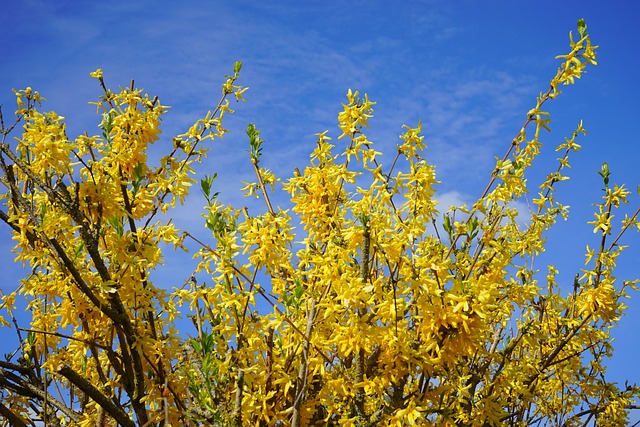Forsythia Is Safe for Dogs, Cats & Horses
Forsythia aka “Golden Bells” is not popular in California where I have been growing Lovie’s Pet Safe Garden, so this is not one of the plants that I am personally familiar with, however, I like to feature plants that are popular and pet safe. It appears to be more of an East Coast plant with a reach as far as New Mexico- so close! I like drought resistant shrubs and perennials because they provide year-round life (and color if they are flowering) and they can grow tall enough to provide some privacy especially with a little boost in a container garden.

Physical Attributes
| Attribute | Description |
|---|---|
| Plant Type | Deciduous shrub[3] |
| Height | 3-10 feet[3] |
| Width | 4-7 feet[3] |
| Growth Rate | Medium[3] |
| Habit | Arching, erect, multi-stemmed, spreading[3] |
| Leaves | Opposite, simple, ovate to lanceolate, 1-3 inches long, green[3] |
| Flowers | Bright golden yellow, trumpet-shaped, 4-5 petals, 1-3 inches wide, bloom in early spring before leaves emerge[1][3] |
| Fruit | Two-celled capsule with winged seeds[3] |
General Care Tips
- Grow in full sun to partial shade[3]
- Prefers well-drained soil high in organic matter[3]
- Low maintenance shrub[3]
- Hardy in USDA zones 5-8[3]
- Prune after flowering to shape and control size[1]
- Vigorous grower, good for borders, hedges, or mass planting[1][2]
- Grows well in Eastern United States south to North Carolina and west to Tennessee
- Well-adapted and a popular spring-blooming shrub in: Santa Fe area of New Mexico
Fun Facts
- Commonly called “Easter Tree” as the yellow flowers bloom around Easter time[3]
- Among the first shrubs to flower in spring, signaling the end of winter[1]
- Flowers are edible and can be used to make forsythia wine or forsythia vinegar[3]
- Native to Asia and southeastern Europe, introduced to other regions as an ornamental plant[3]
- The genus name Forsythia honors William Forsyth, a Scottish botanist[3]
Forsythia aka Golden Bells Is Non-Toxic to Dogs, Cats & Horses
So you know, we check all the plants, flowers, and shrubs we feature on our site with the ASPCA and do extensive internet research for both the common and scientific name just to be super pet safe. If we cannot find direct reference, we check up to genus and so on until we can confirm whether a plant is toxic or non toxic to both cats and dogs. If we are not sure, or get contradictory information, we do not include it. Many of the plants featured we have grown successfully in our own pet safe garden in Northern California. You can see many of garden stars in photos from Lovie’s Pet Safe Garden.
| Consideration | Details |
|---|---|
| Container Friendly | No, forsythia is not well-suited for containers as it grows quite large.[1][3] |
| Indoor/Outdoor | Outdoor plant only.[1][3] |
| Sun/Shade | Prefers full sun to partial shade.[1][3] |
| Perennial/Annual | Perennial deciduous shrub.[1][3] |
| Flowering | Bright yellow flowers bloom in early spring before leaves emerge.[1][3] |
| Drought Tolerant | Yes, once established it has good drought tolerance.[2][4] |
| Pollinator Magnet | Yes, bees and butterflies are attracted to the early spring blooms.[2] |
| Beginner Friendly | Yes, forsythia is a low-maintenance, easy to grow shrub.[1][2] |
| Good Ground Cover | No, it grows too large and upright to be an effective ground cover.[1][3] |
| Good Privacy Screen | Yes, forsythia makes an excellent privacy hedge or screen.[1][4] |
| Invasive/Spreader | Can spread vigorously if not pruned regularly.[1][4] |
| Hardy/Delicate | Hardy, withstanding cold temperatures well.[3][4] |
| Rodent Repellent | No evidence it repels rodents.[1][2][3][4] |
| Deer Resistant | No, deer may browse on forsythia.[4] |
| Ideal States/Native To | Native to Asia and southeastern Europe, but widely grown as an ornamental shrub.[3][5] |
Citations:
[1] https://sammysplantworld.com/products/forsythia-lynwood
[2] https://www.homedepot.com/p/BELL-NURSERY-3-Gal-Lynwood-Gold-Forsythia-Flowering-Shrub-with-Yellow-Flowers-FORSY3LGD1PK/318510152
[3] https://plants.ces.ncsu.edu/plants/forsythia/
[4] https://cjgardeningcenter.com/products/golden-bells
[5] https://www.chicagobotanic.org/plantcollections/plantfinder/forsythia_x_intermedia_golden_bells–golden_bells_forsythia
[6] https://kallecoplantnursery.com/forsythia-plant-profile/
[7] https://www.thespruce.com/forsythia-bushes-plants-that-herald-spring-2131177
[8] https://www.rhs.org.uk/plants/forsythia
[9] https://hgic.clemson.edu/factsheet/forsythia/
[10] https://www.britannica.com/plant/forsythia





